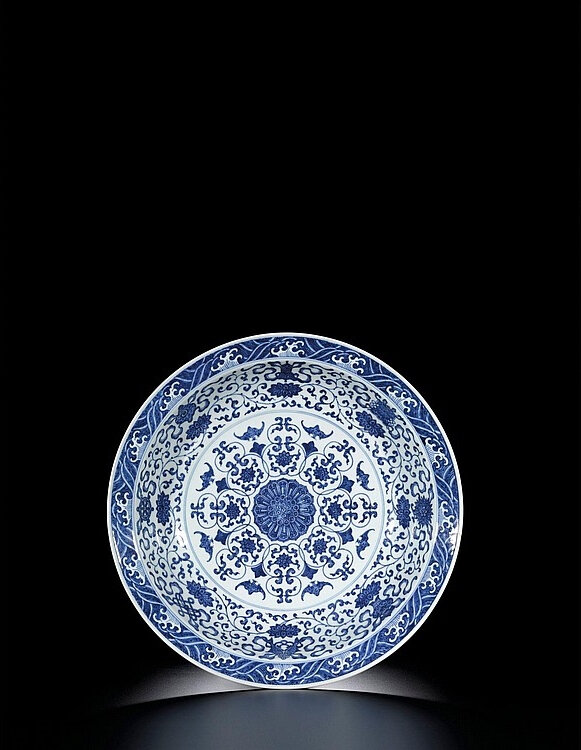An extremely large blue and white 'bajixiang' dish, Seal mark and period of Qianlong (1736-1795)
Lot 3131. An extremely large blue and white 'bajixiang' dish, Seal mark and period of Qianlong (1736-1795); 43.9 cm., 17 1/4 in. Estimate 500,000 — 700,000 HKD. Lot Sold 3,620,000 HKD. Photo Sotheby's.
robustly potted with shallow curved sides supported on a tapered foot rising to a flat rim, vividly painted in the centre with a stylised lotus enclosed by flying bats and florets, the cavetto decorated with beribboned bajixiang above lotus blossom scrolls, all within a continuous band of cresting waves at the rim, the underside with further bats hovering above turbulent waves crashing against rocks, encircling the countersunk base inscribed in underglaze blue with a six-character reign mark.
Provenance: Sotheby's Hong Kong, 29th April 1992, lot 139.
Exhibited: Min Chiu Society (according to label).
Note: The present dish is impressive for it large size and carefully composed design, and no other example of this type appears to have been published. For the prototype of this dish see a slightly larger example with a similarly composed design on a yellow ground, with a Yongzheng reign mark and of the period, sold in these rooms, 20th November 1985, lot 156.
The bajixiang originated in India and came into China with the introduction of Tibetan Buddhism in the Yuan dynasty (1279-1368), and was immediately incorporated into the decorative arts. During the early seventeenth century these Buddhist symbols became integrated with Daoist symbols and came to share the same meaning of longevity. The combination of the bajixiang resting on lotus flowers and the interlocking scrolls derives from the blue and white palace bowls and stemcups of the Chenghua dynasty (1465-87); for example, see a stemcup included in the exhibition A Legacy of Chenghua. Imperial Porcelain of the Chenghua Reign Excavated from Zhushan, Jingdezhen, Tsui Museum of Art, Hong Kong, 1993, cat. no. C52.
Sotheby's. Fine Chinese Ceramics and Works of Art, Hong Kong, 08 april 2011

/https%3A%2F%2Fprofilepics.canalblog.com%2Fprofilepics%2F1%2F0%2F100183.jpg)
/https%3A%2F%2Fstorage.canalblog.com%2F03%2F02%2F119589%2F96711876_o.jpg)
/https%3A%2F%2Fstorage.canalblog.com%2F11%2F31%2F119589%2F94773502_o.jpg)
/https%3A%2F%2Fstorage.canalblog.com%2F20%2F83%2F119589%2F94772815_o.jpg)
/https%3A%2F%2Fstorage.canalblog.com%2F26%2F72%2F119589%2F75604929_o.jpg)
/https%3A%2F%2Fstorage.canalblog.com%2F59%2F60%2F119589%2F26458628_o.jpg)




/image%2F1371349%2F20240416%2Fob_2a8420_437713933-1652609748842371-16764302136.jpg)
/image%2F1371349%2F20240414%2Fob_83ee65_2024-nyr-22642-0954-000-a-blue-and-whi.jpg)
/image%2F1371349%2F20240414%2Fob_15808c_2024-nyr-22642-0953-000-a-blue-and-whi.jpg)
/image%2F1371349%2F20240414%2Fob_e54295_2024-nyr-22642-0952-000-a-rare-blue-an.jpg)